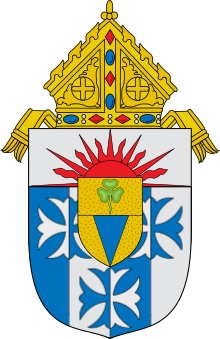Edwin Vincent O'Hara
| Styles of Edwin O'Hara | |
|---|---|
.svg.png) | |
| Reference style | The Most Reverend |
| Spoken style | Your Excellency |
| Religious style | Monsignor |
| Posthumous style | not applicable |
Edwin Vincent O'Hara (September 6, 1881 – September 11, 1956) was an American prelate of the Roman Catholic Church.
Early life
Edwin O'Hara was born in Lanesboro, Minnesota, as one of eight children. His parents emigrated from Ireland during the potato famine and settled in the United States. O'Hara studied at St. Paul's Seminary before moving to Oregon City. He was ordained to the priesthood on June 9, 1905, and then served as a chaplain during World War I.
Ministry
After the war, O'Hara did pastoral work in the Archdiocese of Portland in Oregon, and was a leading force in enacting a minimum wage law through the state legislature in 1913;[1] he later became the defendant in Stettler v. O'Hara when the law was tested and upheld in the U.S. Supreme Court in 1917.[2] He was chosen to be chairman of Oregon's Industrial Welfare Commission in 1913 as well. In 1923, he became founder and director of the National Catholic Rural Life Conference, inspired by his ministry to those who lived in sparsely populated areas. According to him, "The Church is the biggest single factor in building up rural communities."[1]
On August 6, 1930, O'Hara was appointed the second Bishop of Great Falls, Montana by Pope Pius XI. He received his episcopal consecration on the following October 28 from Archbishop Edward Howard, with Bishops Charles White and Joseph Crimont, S.J., serving as co-consecrators. In 1931, he was the only American bishop present when Pius XI delivered his encyclical Quadragesimo anno, and spoke for the United States as delegates from each Christian nation reported the effects of Rerum novarum.[3]
O'Hara was later named Bishop of Kansas City, Missouri on April 15, 1939. In 1940, he derided physicist Albert Einstein after the latter expressed his disbelief in a personal god, saying, "It is sad to see a man, who comes from the race of the Old Testament and its teaching, deny the great tradition of that race".[4] Within his first ten years as Bishop, the diocese built or bought 42 churches, 31 rectories, 24 colleges, high schools, and grade schools, 14 convents, eight social centers, and six hospitals. Of the 30 churches he constructed in rural counties, 25 of them had never had a Catholic church before.
O'Hara was considered to be theologically liberal, particularly in the fields of liturgy and social justice. A proponent of Catholic Action, he encouraged lay involvement and appointed laypeople to several top diocesan positions. Some believed he went too far in his promotion of the laity, leading even his own chancellor to resign in disapproval.[5] O'Hara also led the effort to revise the Bible in simpler terms.[6] On June 29, 1954, he was granted the personal title of Archbishop.
Archbishop O'Hara died in Milan, Italy,[6] shortly after his 75th birthday. He is buried in Kansas City.
See also
References
- 1 2 The Busy Bishop TIME , September 26, 1949
- ↑ http://www.jiffynotes.com/a_study_guides/book_notes/eamc_05/eamc_05_02404.html
- ↑ Catholics for LaborTIME June 2, 1941
- ↑ Dawkins, Richard. "The God Delusion". Mariner Books, 2006.
- ↑ National Catholic Reporter. Extreme Makeover: The Diocese May 12, 2006
- 1 2 New New TestamentTIME May 12, 1941
Further reading
- Dolan, Timothy (2012). Some Seed Fell on Good Ground. The Life of Edwin V. O'Hara. Washington, DC: Catholic University of America Press. ISBN 978-0-8132-1949-3.
External links
| Wikisource has original works written by or about: Edwin Vincent O'Hara |
| Catholic Church titles | ||
|---|---|---|
| Preceded by Mathias Clement Lenihan |
Bishop of Great Falls 1930–1939 |
Succeeded by William Joseph Condon |
| Preceded by Thomas Francis Lillis |
Bishop of Kansas City 1939–1956 |
Succeeded by John Patrick Cody |


